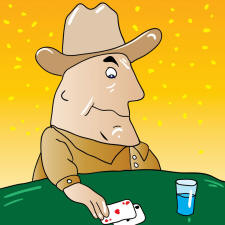The Differences Between Fixed Limit and Pot Limit Omaha
If you're even slightly familiar with poker terms, you've probably heard the words fixed limit, pot limit, and no limit. Each term refers to the betting limits at a poker table, and places a cap on how much money each player can put into the pot when it is their turn to act. No Limit means that any player can bet any amount at any time (as long as it's at least equal to the minimum bet at the table).
Things get a little trickier when it comes to Pot Limit and Fixed Limit. If you're an Omaha poker player, you'll most likely be playing at a Pot Limit or Fixed Limit table, as most sites don't offer No Limit Omaha. If you're trying to choose what betting variation to play, the first step is to understand how each variation works. The rest of this article will explain Fixed Limit and Pot Limit Omaha, and the differences between each game.
Fixed Limit Omaha
 "Fixed Limit" means that there is a fixed amount of chips
that you can bet per round. Also, depending on where you are
at in the hand, you can either make a "big bet" or a "small bet".
These betting limits are determined by the stakes of the table. For
example, if you're at a $1/$2 table the small bet would be $1, and the big
bet would be $2. Small bets are the increments used preflop and on the
flop, and big bets are the increments used on the turn and river.
Also, a maximum of four bets can be made during each betting round.
"Fixed Limit" means that there is a fixed amount of chips
that you can bet per round. Also, depending on where you are
at in the hand, you can either make a "big bet" or a "small bet".
These betting limits are determined by the stakes of the table. For
example, if you're at a $1/$2 table the small bet would be $1, and the big
bet would be $2. Small bets are the increments used preflop and on the
flop, and big bets are the increments used on the turn and river.
Also, a maximum of four bets can be made during each betting round.
For example, if you're playing $1/$2 Fixed Limit Omaha, preflop bets have to be made in increments of $1. If a player chooses to raise, he/she can only raise to $2. The maximum raise that can be made is $4, and that would only occur if you were raising a player who had already made a $3 bet. On the turn or river, bets can be made in increments of $2, and the maximum bet is $8.
Pot Limit Omaha
Pot Limit betting resembles No Limit more betting than Fixed Limit betting. There are no fixed betting stakes, but there is a betting "cap" that determines the maximum bet you can make. At any given time a player can only bet or raise an amount equal to the present size of the pot. The best way to explain this is through an example:
Imagine you're at a $1/$2 Pot Limit Omaha table. The small blind would be $1, and the big blind would be $2. If you're the first player to act, the maximum raise you could make would be $7 total. Since there is already $3 in the pot ($1 small blind and $2 big blind), plus your $2 call, you can make a raise of $5. The $5 raise plus your $2 call is $7 total, so that is why the maximum raise is $7.
Another example would be if you're at the river of a hand facing a $20 bet. If the total pot size is already $70, the maximum raise you could make would be $180 total. The present pot size would be $90 (including your call of his $20 bet), so you could double that to $180 total.
Conclusion
Once you know the basics of Fixed Limit and Pot Limit Omaha, it's not that hard to make a decision as to which you wish to play. I recommend that if you'd prefer a more mathematical approach to the game, and focus more on pot and implied odds, play Fixed Limit Omaha. However, if you're more of a "feel" type player and like to make bluffs in Omaha, I'd recommend Pot Limit Omaha. Good luck, and enjoy!
